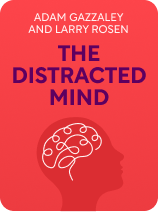

This article is an excerpt from the Shortform book guide to "The Distracted Mind" by Adam Gazzaley and Larry Rosen. Shortform has the world's best summaries and analyses of books you should be reading.
Like this article? Sign up for a free trial here.
How strong is the cognitive control network? Why is it easy for humans to fall for interference?
The cognitive control network guides us to achieve our goals in life. But it does have its limits, which is why humans get distracted so easily and sometimes can’t fulfill those goals.
Continue reading to learn how your cognitive control network might be failing you.
How Cognitive Control Limitations Make Us Susceptible to Interference
In The Distracted Mind, Adam Gazzaley and Larry D. Rosen argue that we’re susceptible to interference because our cognitive control network—the group of faculties that allow us to fulfill our goals—has limitations that make us susceptible to interference. To show as much, they examine these three faculties (attention, working memory, and goal management) to highlight their shortcomings.
Faculty #1: Attention
According to Gazzaley and Rosen, the first component of cognitive control is attention. They write that attention is similar to a spotlight since it allows us to attend to particular stimuli in our environment. For example, attention can allow us to focus on the car in front of us in a traffic jam, the scent of pretzels in a mall, or the crying baby in a movie theater.
When it comes to meeting our goals, Gazzaley and Rosen argue that the ability to focus on particular stimuli increases our brain’s efficiency by filtering out irrelevant information. For instance, imagine that you’re a concert pianist performing a concerto. Instead of fixing your attention on all the other stimuli present, such as the whispers of the crowd or the lighting on stage, you selectively focus on the piano in front of you to maximize your performance.
(Shortform note: Although scientists regularly liken attention to a spotlight, other experts suggest this comparison is mistaken. Indeed, while the spotlight comparison is meant to highlight our ability to attend to one single stimulus, some experts argue that we can simultaneously attend to two different visual stimuli. Consequently, they suggest that the spotlight comparison isn’t perfectly apt since we can “split the spotlight.”)
However, our capacity for selective attention has limits. In particular, Gazzaley and Rosen note that our attention can be derailed by environmental stimuli that catch our attention, such as sudden movements or loud noises. If, for instance, you’re conversing with a friend in a coffee shop, your attention might falter if your favorite song comes on the radio. Although this responsiveness to environmental stimuli originally provided survival benefits, such as alerting us to nearby predators, it now detracts from our goals by providing us with frequent interference.
(Shortform note: Although all environmental stimuli have the potential to disrupt our attention, certain stimuli prove more disruptive than others. Neuroscientists agree that emotionally significant stimuli—for instance, angry scowls and crying toddlers—are more likely to catch our attention. Though the reasons behind this are unclear, the experts speculate that the human brain is hardwired to perceive stimuli of personal and social import, which are inevitably tied to emotions.)
Faculty #2: Working Memory
Next, Gazzaley and Rosen discuss working memory, the faculty that allows us to retain key pieces of information in our mind over short time spans. They argue that working memory is crucial in executing higher-level goals because it allows us to decide how to act on the basis of past perceptions. For example, imagine that you’re driving to a new location after checking the directions at home; your working memory enables you to recall those directions and thus correctly decide which turns to make.
(Shortform note: In addition to working memory, our capacity for long-term memory, which allows us to store information for indefinite periods of time, aids us in accomplishing longer-term goals. For example, if you’re a law student with the goal of passing the bar, your long-term memory will prove crucial in helping you remember information from your first year of law school.)
But, just like attention, our working memory is saddled with limitations that make us vulnerable to interference. Specifically, Gazzaley and Rosen cite experiments showing that working memory is limited in its accuracy (especially as time goes on) and its storage capacity—and interference can exacerbate these weaknesses. For example, when distractions and interruptions arise, they claim, we all find it much more difficult to remember what was on our mind; if you’re trying to remember someone’s phone number and get distracted by, say, a baby crying nearby, you’ll find that the number has vanished from your working memory.
(Shortform note: In a separate article, Gazzaley and other neuroscientists performed a study showing that, although all forms of interference harm working memory, interruptions are considerably more harmful than distractions. They attributed this disparity to the fact that unlike distractions, interruptions require us to redirect our mental resources away from our original goal and toward a new one.)
Faculty #3: Goal Management
Finally, Gazzaley and Rosen turn to goal management, our capacity for dividing up tasks to accomplish multiple goals within a fixed timeframe. They write that, because humans evolved to juggle multiple goals concurrently, goal management is essential for deciding which tasks to prioritize.
(Shortform note: “Goal management” is different from “task prioritization,” which refers to the process of arranging tasks in order of importance to help divvy up resources. Whereas task prioritization typically focuses on the individual tasks required to reach one goal, goal management is a broader process that involves organizing multiple goals at once and balancing the tasks needed to pursue these goals simultaneously rather than one at a time (as in task prioritization).)
Goal management, they note, is a combination of two abilities: multitasking and task-switching. Multitasking refers to an attempt to perform multiple tasks simultaneously; for example, you might speak to someone on the phone while driving your car. Task-switching, by contrast, refers to performing different tasks in quick succession, like switching back and forth between your Spanish homework and your math homework. Both of these abilities represent ways to juggle competing goals that you might have.
However, our capacity for goal management also has shortcomings. With respect to multitasking, Gazzaley and Rosen note that our brain can’t process two streams of information at once, meaning we can’t actually multitask—our attempts to do so are actually just a form of rapid task-switching. With respect to task-switching, the authors point out that experiments have shown we suffer performance decreases when we switch between two tasks, as we become less efficient performing the second task. For these reasons, our secondary goals can become a form of interference that harms our ability to fulfill our primary goals.
(Shortform note: Gazzaley and Rosen’s claims about multitasking are in line with the scientific consensus—in the overwhelming majority of cases, what we call “multitasking” is actually quick task-switching. In light of this consensus, experts offer several pieces of advice for efficiently working without attempting to multitask. For example, try to focus on one task at a time until your attention span wanes—usually at about 20 minutes. Moreover, don’t be afraid to work in isolation to prevent other tasks from capturing your attention.)

———End of Preview———
Like what you just read? Read the rest of the world's best book summary and analysis of Adam Gazzaley and Larry Rosen's "The Distracted Mind" at Shortform.
Here's what you'll find in our full The Distracted Mind summary:
- How technology has made us more prone to distractions and interruptions
- How to modify your environment to reduce distractions and boredom
- How to minimize your susceptibility to interference and improve cognitive control






